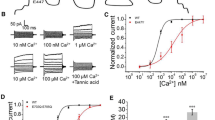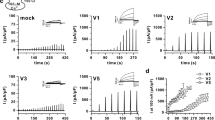Abstract
Calcium-activated chloride channels (CaCCs) play fundamental roles in numerous physiological processes. Despite their physiological importance, the molecular identity of CaCCs has not been fully investigated until now. Recently, transmembrane 16A (TMEM16A) was demonstrated by three independent research groups to be a strong candidate for the CaCC molecular basis. To further investigate the electrophysiological characteristics, we constructed TMEM16A (abcd) stably transfected HEK293 cell lines and carried out whole-cell and excised inside–out patch-clamp experiments. The TMEM16A channel was Ca2+-dependent in both patch configurations. The TMEM16A current could be strongly inhibited by niflumic acid, and when Cl− was substituted by gluconate ions, the current was reduced considerably. In inside–out configuration, TMEM16A channel was time-independent but voltage-dependent, in which the half-maximum activating free Ca2+ concentration was 63 nM at 80 mV. While in whole-cell configuration, the current was both time- and voltage-dependent. About the rectification feature, the TMEM16A current also showed distinct characteristics in the two patch configurations. In whole cells, the TMEM16A channel expressed outward rectification at low Ca2+ concentration but when the Ca2+ concentration was high it became linear. On the contrary, in inside–out configuration, it always expressed outward rectification. Comparing the different characteristics in the two configurations, some underlying mechanisms remain to be identified, which is discussed with respect to direct or indirect activation. There was irreversible rundown in this channel.




Similar content being viewed by others
References
Barish ME (1983) A transient calcium-dependent chloride current in the immature Xenopus oocyte. J Physiol 342:309–325
Caputo A, Caci E, Ferrera L et al (2008) TMEM16A, a membrane protein associated with calcium-dependent chloride channel activity. Science 322:590–594
Eggermont J (2004) Calcium-activated chloride channels: (un)known, (un)loved? Proc Am Thorac Soc 1:22–27
Galietta LJV (2009) The TMEM16 protein family: a new class of chloride channels? Biophys J 97:3047–3053
Hartzell C, Putzier I, Arreola J (2005) Calcium-activated chloride channels. Annu Rev Physiol 67:719–758
Hartzell HC, Yu K, Xiao Q et al (2009) Anoctamin/TMEM16 family members are Ca2+-activated Cl− channels. J Physiol 587:2127–2139
Jia QZ, Jia ZF, Zhao ZY et al (2007) Activation of epidermal growth factor receptor inhibits KCNQ2/3 current through two distinct pathways: membrane PtdIns(4, 5)P2 hydrolysis and channel phosphorylation. J Neurosci 27:2503–2512
Kaneko H, Mohrlen F, Frings S (2006) Calmodulin contributes to gating control in olfactory calcium-activated chloride channels. J Gen Physiol 127:737–748
Pifferi S, Dibattista M, Menini A (2009) TMEM16B induces chloride currents activated by calcium in mammalian cells. Pflugers Arch 458:1023–1038
Reisert J, Lai J, Yau KW et al (2005) Mechanism of the excitatory Cl− response in mouse olfactory receptor neurons. Neuron 45:553–561
Schroeder BC, Cheng T, Jan YN et al (2008) Expression cloning of TMEM16A as a calcium-activated chloride channel subunit. Cell 134:1019–1029
Xie W, Kaetzel MA, Bruzik KS et al (1996) Inositol 3,4,5,6-tetrakisphosphate inhibits the calmodulin-dependent protein kinase II–activated chloride conductance in T84 colonic epithelial cells. J Biol Chem 271:14092–14097
Yang YD, Cho H, Koo JY et al (2008) TMEM16A confers receptor-activated calcium-dependent chloride conductance. Nature 455:1210–1215
Acknowledgements
We thank Dr. Jia Zhanfeng and Dr. Zhang Xuan for their help and discussion on experimental technology. This study was supported by Grants from the National Natural Science Foundation of China (10975045, 10775038) and the Natural Science Foundation of Hebei Province (C2009000029).
Author information
Authors and Affiliations
Corresponding author
Rights and permissions
About this article
Cite this article
Chen, Y., An, H., Li, T. et al. Direct or Indirect Regulation of Calcium-Activated Chloride Channel by Calcium. J Membrane Biol 240, 121–129 (2011). https://doi.org/10.1007/s00232-011-9350-1
Received:
Accepted:
Published:
Issue Date:
DOI: https://doi.org/10.1007/s00232-011-9350-1




